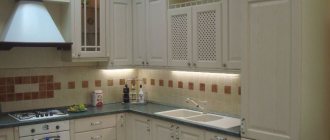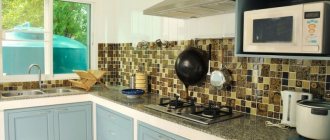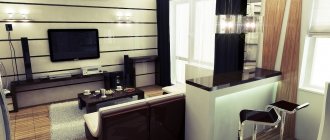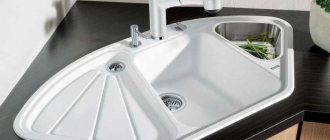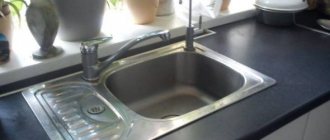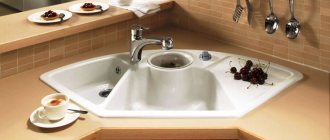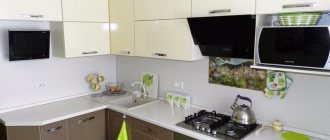A corner sink is an excellent solution for arranging a small kitchen where you have to save every square meter. It takes up much less space than a regular sink, but is just as convenient and functional.
Installing a corner sink will significantly expand the work area.
When choosing this product, you need to take into account some designer tips in order to create a harmonious kitchen interior, make it comfortable and modern.
Advantages and disadvantages of a corner kitchen sink
This option for arranging a kitchen is most often used when using an L-shaped layout, which allows you to create the most comfortable space in the kitchen.
The corner sink is the most popular option in the kitchen.
Advantages of this solution:
- There is a significant saving of space in the kitchen, thanks to which you can equip a larger countertop, as well as equip several additional places for storing kitchen utensils.
- Thanks to the huge range of similar designs, which are available in different sizes, shapes and colors, you can fit a corner sink into any interior.
- A kitchen with a corner sink always provides more comfortable conditions for the housewife, as she has to move around the room less - all the most important work areas are located close to each other.
- Under the corner sink, more free space is created, which is perfect for installing a trash can, as well as for storing household chemicals, large dishes and other kitchen utensils that take up a lot of space.
However, there are some disadvantages of a corner sink:
- If you install a sink that is too large, the corner located directly behind it can become a so-called “dead zone”. However, such a place is perfect for placing various kitchen items that should always be at hand.
- If plumbing repairs are required, it will not be very convenient to carry out it, since the door of the corner cabinet located under the sink is always much smaller than the space that is hidden behind it.
When installing a corner sink in the kitchen, it is important to take into account all the nuances of this solution, because sometimes even replacing water filters, which will have to be done regularly, can become a real problem.
Advice! To install the ideal sink in the kitchen, providing maximum convenience to the household, you should evaluate different options for designs, shapes, sizes and materials.
Advantages and disadvantages
To choose a convenient sink that fits harmoniously into the interior, you need to carefully evaluate all the criteria: design, size, material.
Corner sinks are good because:
- Save space. There is enough free space on the countertop for culinary affairs and placement of cooking utensils.
- Available in various combinations of color, size, shape. Thanks to this, it is easy to choose an option that fits into any interior.
- They make the housewife's work more comfortable. There is no need to run from one end of the kitchen to the other, since the countertops are conveniently located on both sides of the sink.
- They leave a lot of free space in the area under the washing structure. A spacious corner bedside table holds a trash can, bags of vegetables, jars, bulky dishes, and other kitchen items that require a lot of space.
But corner sinks also have disadvantages:
- Installing a large sink at the back creates a large piece of empty countertop. But housewives find uses for this place: they put detergents there, put frequently used household items.
- Plumbers don't like corner structures. The cabinets under the sink are spacious, but have a narrow door, making it difficult for repair workers to reach damaged pipes.
Materials from which corner sinks are made
Ceramics - this material is used to make attractive looking products that can decorate any kitchen. Ceramic sinks can be white, with patterns, or colored. They go well with classic interior styles, as they look respectable and elegant.
Ceramic sinks are typically made from high-quality materials such as kaolin and fire clay.
The advantages of ceramic sinks are their high resistance to hot water and household chemicals. There are no scratches on their surface, and such sinks do not require special care. The disadvantage of a corner ceramic sink is its considerable weight, increased fragility, some difficulties during installation, and the possibility of cracks and chips forming over time.
Artificial stone - a corner sink made of this material will look luxurious in any interior. This product is of high quality; it can last for many years without losing its visual appeal.
Natural and artificial stone are quite durable and have many advantages.
The main advantages include the following characteristics: ease of maintenance, resistance to direct sunlight, and the ability to absorb water noise.
Artificial stone is not afraid of detergents and hot water. The range of such products is quite wide. However, it is worth considering that a corner sink made of synthetic stone is not cheap.
Stainless steel - this material is most often used in the manufacture of sinks, including corner sinks. Stainless steel products can have a matte surface or a glossy finish; various images can even be applied to their surface.
A stainless steel sink fits any interior and can be combined with different types of countertops.
Advantages of a stainless steel sink: neat and attractive appearance, affordable cost, corrosion resistance. You can install this product yourself.
There are also some disadvantages - this is the ability to produce a lot of noise when in contact with water flowing from the tap.
What types of corner sinks are there?
So, if you have already decided on the type of angle, then it’s time to start directly choosing a sink . The space of options here is truly endless: you can satisfy the most demanding aesthetic needs, but the ideal option is a compromise between sincere sympathy for lines and shapes and the practical convenience of a particular option.
Material
If you look at the material from which they are made, then most often it is:
- stainless steel - cheap and cheerful;
- artificial stone is much more expensive and even more impressive both in terms of use and appearance;
- ceramics - can be either with a glossy or matte surface, looks great in kitchens of any stylistic format.
If you are so tempted to save money and choose “stainless steel”, then be prepared for the constant noise that is created by the stream of water breaking on the surface of the bowl. In addition, the service life of such a sink will inevitably be less than the other two options.
Depth
The ease of use of the sink depends on the depth of the sink. There are certain standard values that are used in most cases - these are 18-20 centimeters.
Anything smaller is considered a small bowl, anything larger is considered a large bowl (up to 25 cm).
However, these numbers should not be taken so unequivocally: in the end, context decides everything. If, for example, you have a small kitchen, then a shallow sink will allow you to deceive the visual perception a little and make the room appear larger.
Form
There are no comrades in taste and color. The same can be said about the shape of the bowl for installation in a corner kitchen set. Some people prefer the strict dictates of straight lines and do not accept compromises, while others, on the contrary, fall into aesthetic ecstasy at even the slightest hint of roundness. We invite you to find out what you like best.
Square
A classic option that can be found probably in every second kitchen. Its demand is quite justified - it’s convenient, after all.
Some square sinks may have rounded corners.
Rectangular
Also a popular shape with strict line geometry. Compared to the same square, it is more spacious.
Triangular
An interesting option that will certainly fit brilliantly into a modern interior. Including small rooms.
Round and oval
The capacity of such bowls leaves much to be desired. However, they are indispensable if your interior has a lot of rounded lines. Otherwise, a strict rectangular sink will look like a foreign body.
Plus, the absence of corners plays into the hands of pedantic housewives - caring for such a sink takes less time.
Beveled (trapezoidal)
They provide owners with a much larger internal volume. If your family is large, then it’s worth considering!
Functional
Sinks, of course, influence the perception of the design of the room, but first of all they perform a practical function. Accordingly, the better adapted this or that option is to solve the maximum possible number of problems, the more attractive it seems in the eyes of the consumer.
With two bowls
The presence of a second bowl significantly expands your arsenal of actions: you can use the main one for washing, and the additional one for drying fruits or vegetables.
The bowls can be the same in volume, but more often there are options where the additional one is about 2 times smaller. It is often used for drying cutlery and for defrosting.
With additional surface
They are often also called sections. Such surfaces form a wing and are typical for pentagonal and hexagonal sinks.
Functionally, everything is simple here: you can place washed dishes on such a section so that they dry faster - droplets of water will still flow into the main drain.
There may be several additional sections - it all depends on how much space you are willing to allocate for them. But we still recommend that you do not turn your kitchen unit into one continuous appendage of your sink.
Methods for attaching corner sinks
Overhead corner sink - to install such a design, you need a separate kitchen cabinet. A sink of this type replaces a full-fledged countertop. You can try to install it yourself, but this process is quite complicated, so it is still better to trust a specialist. This sink is perfect for any kitchen.
The overlay design looks very organic and can have different stylistic configurations.
It is very important that it is inexpensive, weighs little, and at the same time looks very dignified and attractive. Corner overhead sinks are manufactured in different shapes and sizes, equipped with one or two bowls.
Built-in sink - a corner sink of this type is deservedly popular among many housewives. This product can be installed even with your own hands, without the help of specialists. The built-in sink is ideal for any countertops, regardless of the material they are made of.
A built-in sink requires good waterproofing, as it cuts into the surface of the countertop.
The product is durable and high quality. Built-in sinks come in different varieties; they differ in bowl depth, size, and number of bowls.
The main features of the product: ease of use, significant space saving in the kitchen, the ability to be built into a set of any size, the ability to complete according to your own taste (add a drying rack, colander, chopping tray, etc.), multifunctionality.
Fastening
The second point regarding the sink that you need to decide on is how to attach it. There are four options in total:
- The overhead sink is the easiest sink to install, and it’s also inexpensive. It is as easy to put on as a hat on your head. The only downside of this type of fastening is that water can get into the end of the “cap” and cause the tabletop to swell if it is located nearby. This option is rarely found for corner sinks.
- Mortise - the most common sink mount. The bottom line is that a special hole is cut out in the countertop into which the sink is inserted and secured in various ways. The complexity of installation depends on the materials - it is much easier to make a hole in an MDF countertop than in a stone one. And it’s easier to work with a stainless steel sink than a composite one. Literally. But such a mount saves space in the kitchen and also fits into any interior.
- Under-table (built-in, built-in) is the most modern method of mounting. The sink is installed under the countertop. Installation is very difficult, so most often a professional is required.
- Integrated - in this situation, there is no concept of a “sink” as such, because it, together with the countertop, represents a single whole.
Varieties of corner sinks by number of bowls
The single-bowl corner sink is the most compact and simple model. It is perfect for a kitchen with limited space and a small work surface. This sink does not take up much space, it is ergonomic and helps save kitchen space.
Very often, single-bowl sinks are made in a rectangular shape, with slightly rounded edges. A design of this type, even with the most compact dimensions, is quite comfortable, functional and roomy.
A single-bowl kitchen sink is considered the most simple, convenient and spacious.
To save as much space as possible in the kitchen, it is recommended to give preference to a round single-bowl sink made of stainless steel.
The best option is a round single-bowl sink.
Corner sink with two bowls - such models are most often installed in one line, but corner installation is also possible - at an angle to the tap. This type of sink is very functional, but it is better to use it in larger kitchens.
The mixer should be installed so that both bowls can be used comfortably.
Design tips
A few more tips to help you choose the perfect corner sink for your kitchen.
- The best solution would be to look at the sink in person and evaluate its real appearance.
- It is important to consider the family's eating habits - how often food is prepared or dishes are washed. If the family is small and the kitchen is even smaller, then you can get by with a corner sink 45 centimeters wide.
- Another reason to choose a small sink is the availability of a dishwasher. The main thing is to focus on depth so that it is convenient to rinse large frying pans and pots.
- It is worth paying attention to the thickness of the material and the height of the sides. The thicker they are, the more practical they are.
- Don't forget about the faucet, especially if it is built into the countertop - in this case, it is important to check its compatibility with the sink. It’s better to go choose a sink, carrying the mixer in your hands and “trying on” it.
- The thermostat in the kitchen is a waste of money.
- You need to install the cabinet first, and then think about the sink for it.
- If you really wanted a multifunctional sink with three sections, but this is not possible, then you should think about a faucet with a pull-out “shower”.
- It is also important to look at the strength and rigidity of the structure. For example, a regular stainless steel sink will support a faucet that weighs a maximum of 6.5 kg. Bronze or brass specimens do not fit into these frames.
- Glossy surfaces will often need to be polished until they shine.
- It is worth considering the lighting, since corner sinks are most often located in such a way that the person washing dishes blocks the light.
Types of corner kitchen sinks
Shapes of corner sinks for the kitchen
Round corner sink . Every housewife spends a lot of time in the kitchen, preparing food and doing other household chores. An impractical corner sink will make being in the kitchen a real challenge. To avoid this, you need to choose the most suitable option for a corner sink for the kitchen.
Round sinks have gained popularity relatively recently. Such models are purchased no less often than rectangular and square products. In terms of space, a round sink has increased capacity and therefore has a larger volume.
The round sink fits perfectly into the corner of any kitchen.
The round corner sink has a fairly compact size, so it is ideal for owners of small kitchens. The distinctive features of this model are a wide range of choices, functionality and visual appeal.
The advantages of a round-shaped sink: it is spacious, due to the absence of corners in it, the hygiene of the product increases, and its compact size allows you to save space in the kitchen. At the same time, the design of such a sink looks very original.
Square corner sink . This form of sink is functional, even when used in a small kitchen, with standard countertop dimensions. The square corner sink is spacious.
A similar sink with a side wing will fit perfectly into the interior of a small kitchen.
Sinks of this type are most often made with one bowl, without additional functional components. Corner square sinks are quite in demand, although they are somewhat inferior in popularity to rectangular designs. In addition to convenience and functionality, the square-shaped sink is distinguished by its versatility.
It can even be placed on a countertop of non-standard depth, which opens up wide possibilities for equipping the work surface with some additional elements: wings, bowls, boards and other kitchen accessories.
Forms and methods of arrangement
Corner kitchen sinks come in different configurations:
- round (products with a diameter of 50-60 cm are produced);
- square (considered standard for the kitchen);
- rectangular (this option is most often placed in the corner of a kitchen cabinet; the most popular products are with aspect ratios of 50 by 70, 60 by 80, 70 by 90 cm);
- five or hexagonal (an original, but popular option for kitchen design; many customers ask to install wings and additional containers of different depths).
The design of a kitchen with a corner sink is characterized by variability, determined by the placement and design of the cabinet, the dimensions of the room, and interior features. The sink is installed in any corner of the kitchen unit.
Popular options for the location of plumbing products:
- If the area is located near a window, then placing a sink there is a good idea. Natural light falls on the workspace for a long time; the housewife saves on artificial lighting.
- Kitchen sets with an L-shaped design, equipped with a corner sink of an original shape and color, look attractive. The housewife has enough space for culinary affairs.
- When combining the kitchen and living room, the sink looks good on the bar counter.
- When the room is spacious, equipped with a closet with many corners, the location of the plumbing is determined by the preferences of the owner.
A corner sink is suitable for small-sized units in tight spaces. It saves space.
How to choose the right size corner sink
The dimensions, namely the volumes of bowls for corner sinks, can be very different. Even the smallest sink can have significant depth, just as a large sink can be quite shallow.
When choosing a corner sink of a certain size, you should take into account some parameters: how large the dimensions of the kitchen furniture are, what size dishes household members most often use, and also what is the height of the countertop.
The depth of the sink should be such that when the water is turned on it does not splash out. And also that at least one set of kitchen utensils fits in it.
If the height of kitchen cabinets is about 85 cm, you should not choose bowls that are too deep (more than 20 cm). There is no need for deep sinks even if the kitchen has a dishwasher. The universal bowl size for all types of sinks (including corner ones) is a depth of 16 to 20 cm. This volume is quite enough to avoid splashing water; this depth is convenient for washing pots, pans and plates.
Using examples from the video, you can see what options there may be for rational placement of the sink and accessories.
Arranging a corner drawer under the sink
The cabinet under the sink in corner kitchens has a number of features. If, with a standard layout, only a trash can and a couple of cleaning products fit under the sink, then the free space under the corner bowl turns out to be quite voluminous, but access to it is not entirely convenient. For many, properly organizing a corner cabinet becomes a problem.
It’s easiest for those who need a boiler or a large water filter. In this case, the space under the sink is ideal for these units.
With this arrangement, there is no need to lay extra pipes; all communications are hidden from prying eyes. And the door is wide enough to access the unit if you need to change the filter or carry out minor repairs.
If there is no need for a heating tank or a water filter, the cabinet under the sink can be adapted for storing various things.
Organization of access
Before placing anything under the sink, you need to ensure free access to this place. Modern designers offer several non-standard, but quite practical solutions :
- Corner door. It can be either composite or curved.
- Hinged doors. Convenient, the main thing is not to open on each other.
- Corner drawers. An interesting, but not very practical option (the area around the edges is unused).
- Wide door.
The opening option is selected based on what is planned to be stored under the sink. It is also worth considering the cost of different options, since corner drawers or a curved door will be an order of magnitude more expensive than the usual opening option.
Storage area: life hacks and types of shelves
The area under the sink is quite damp (condensation flowing down the pipes, possible leaks, poorly sealed joint between the sink and the countertop), so it is not suitable for storing electrical appliances and items that are susceptible to moisture.
The boiler and filter don’t count; they were originally designed for frequent contact with water, but an electric drill or screwdriver under the sink can quickly become unusable. The corner drawer under the sink is best suited for storing cleaning products and various utensils.
There are several interesting ideas for arranging the space under the bowl:
- Magic corner. A popular solution for modern designers. The point is that when the door is opened, the shelves move out, thereby providing free access to all contents at once. A very convenient method. The only drawback is the rather high cost of high-quality magic corners.
- Carousel. It has several embodiments, but the essence is the same: the rotating mechanism allows you to move the desired object towards you, instead of having to climb after it yourself. Quite a convenient option, but with this design the corners remain unclaimed, therefore, usable area is lost.
- Hanging and removable shelves. Simple and quick to install and easy to remove if necessary. A budget, but not always convenient solution.
Often, various bloggers and designers give advice on placing detergents, pot lids and similar small things on kitchen doors. This storage method can easily be classified under the heading “bad advice.” This approach creates additional load on the door hinges, causing the door to quickly sag and stop closing.
A well-thought-out design of a corner sink and the space under it helps not only to make good use of every centimeter of free space, but also to create harmony and comfort in the kitchen.
Kitchen corner sink color
As for the color scheme of the corner sink, it should depend on the chosen style of the kitchen interior. Currently, the most popular sinks are white, as well as metallic-colored products (as a rule, they are made of stainless steel).
A wide selection of colors is preferable for sinks made of artificial stone.
Models made in black and gray tones, made of synthetic stone, are becoming increasingly popular. If desired, you can choose any color for the sink - the main thing is to harmoniously fit such a product into the kitchen design.
A corner sink is great for small kitchen spaces.
Real photos of corner kitchens in the interior
Two decades ago, only metal sinks coated with white enamel were sold. Modern design solutions in kitchen design with a corner sink are amazing.
Today, a sink is not just a working plumbing item, but a detail of room design. The photo shows how beautiful and original kitchen interiors with a corner sink are.
Modern manufacturers offer plumbing fixtures to suit every taste and budget. Buyers for whom convenience and ease of use are important purchase stainless steel products.
If you need an expensive-looking interior detail, choose stone. When visual appeal is important, you should pay attention to ceramics.
Accessories for corner sinks
In a plumbing store, when purchasing a corner sink, they can offer a complete set of various useful accessories for everyday life. These can be containers for brushes, soap dishes, drying nets, crossbars for cleaning fruits and vegetables, various containers for storing useful kitchen items. All these items will find their place on the corner sink, and most importantly, they will make the life of every housewife somewhat easier.
The effectiveness of a double sink is obvious: you can wash food and soak dirty dishes in it at the same time.


